Tranalysis
a
Ancient people around the world invented methods of making thread from spindles and spindles. It's an extremely simple technology, the tools are easy to carry and are easy to make from local materials. Skilled craftsmen can use it to spin very strong, fine and uniform threads. The Inca tunic (qompi) is a luxury item worn exclusively by the distinguished elite and is characterized by 80 threads per centimeter of vertical warp yarns alone, or more than 200 threads per inch. But as unique as its products may be, hand spindle spinning is also slow. It took about 400 hours to spin enough thread to make an Inca tunic.
So we can imagine spinning unions in many places coming up with faster ways to get the job done. However, in fact, this situation only happens in China, the birthplace of silk. Only there did some smart people figure out a way to speed up the process-adding conveyor belts and wheels.
This is a paradox. Unlike short fibers, silk is the only long and continuous biological fiber known as "filament". (Synthetic fibers such as polyester and nylon are also made in the form of filaments.) Filaments drawn from an unopened cocoon can stretch for hundreds of yards and do not need to be spun into threads like shorter, more perishable fibers. However, it was the production of silk thread that inspired the first mechanical advancement in spinning.
The first step to turning the cocoon into usable yarn is to soak the cocoon in warm water, which dissolves the sericin that holds the silk together. A silk reeling worker-usually a woman-carefully uses a brush, chopsticks or fingers to draw the filaments from two or more cocoons. The filaments are fused into a single thread, which the reeling worker winds on a huge four-sided winding machine. As the cocoons roll up and down in the water, the assistant can continue to turn the winding machine to loosen the cocoons and pull out the filaments. The more uniform the filaments, the better the quality of the filaments produced. When the filaments in one cocoon are exhausted, workers draw the filaments from the end of another cocoon and fuse them with the continuous thread.
In order to keep rings of wet and slightly sticky silk thread flat and separated from other threads, they must be stretched horizontally and wound on a winding machine large enough to accommodate hundreds of yards of silk thread. Once the silk is reeled and dried, the silk is wound around the bobbin and twisted into a stronger, more shiny yarn if necessary. The process of twisting silk thread is called "twisting silk".
At least this is an ideal situation to produce the precious yarn known as "true silk" by Renaissance Venetians. But not every filament remains intact. The "waste silk" is slightly inferior in quality, but it is still precious and equally crucial to our story. The silk moth in some cocoons can break out of the cocoon and lay eggs. The silk extracted from such cocoons is called waste silk; some waste silk is the fine fluff outside the cocoon; some waste silk is left behind in the pot after the silk reeling process is completed. Silk in the pot. Regardless of the source, waste silk is very useful and in large quantities, and cannot be easily discarded. In the Venetian mainland in the 16th century, waste silk accounted for 1/4 of the total silk. It can be carded and spun like any other staple fiber.
Here we find the answer to this paradox: Silk is both a filament and a short fiber. Chinese silk reeling workers sometimes reel filament and sometimes spin waste silk, in both cases having to wind the silk thread onto a bobbin. Historian Dieter Kuhn claims that from these different production practices, the "first and only labor-saving and time-saving equipment developed for the production of yarns and threads" before the 15th century, the spinning wheel, which mechanized the first two steps of spinning-drawing and twisting the fibers. (In the 15th century, Europeans invented flyers, which could wind wire around a bobbin, making the entire process continuous.)
The inventor of the spinning wheel may have been a silk reeling worker from Shandong, China, a silk production center located between Beijing and Shanghai. Unlike a hand-spindle spinner who relies on gravity, she is already used to reeling on a horizontal machine. She applied the same principle to the spindle. She placed the spindle across and placed the rods on horizontal brackets on either side of the spindle tray so that it could continue to rotate. Then she used a conveyor belt (probably just a rope) to wrap it around the top of the spindle disc, then onto a much larger wheel, and finally back again. The invention was inspired by silk thread wound on a wire winding machine and marked the first use of a conveyor belt, which was an important part of many machines that would later be. Once the big wheel turns, the small spindle disc turns several times.
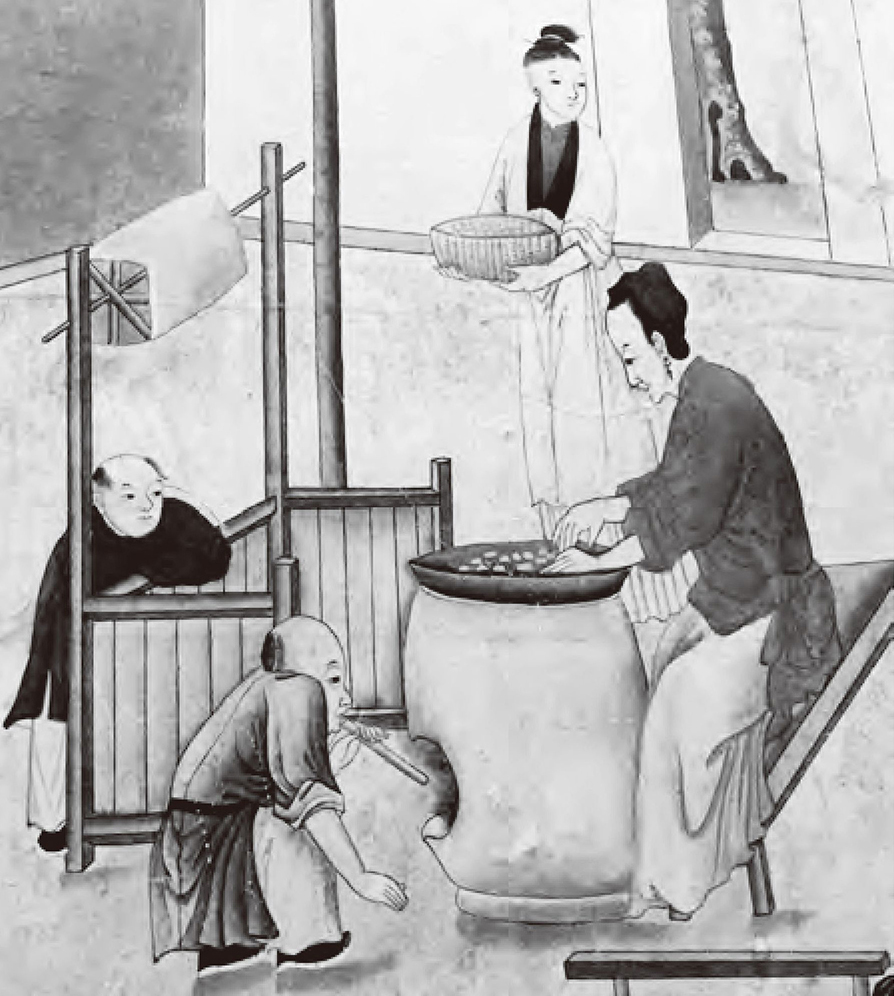
The 18th-century Chinese wallpaper decorated in Govone Castle in Piedmont, Italy's silk producing region, depicts the silk reeling process. Although the scene depicted is a traditional Chinese silk reeling process, the characters 'appearance has been Europeanized to cater to foreign audiences
Kuhn believes that all of this occurred in the fifth or fourth century BC, a full 1000 years before spinning wheels first appeared in India, and spinning wheels eventually spread from India to medieval Europe. Kuhn provided early evidence: a sharp decline in the number of spindles unearthed from Zhou (1046- 256 BC) and Han (206 BC-220 AD) sites suggests that different spinning techniques were used; Han embossed shows that people were using spinning wheels; and a significant increase in the number of silk fabrics woven with twisted silk and double-stranded silk threads unearthed.
But we still don't know when spinning wheels were used specifically for spinning. This is a widely used textile tool and can also be used in other scenes. It can twist silk threads together, as those unearthed silk fabrics show. It can wind finished raw silk onto a bobbin. This process is called "weft winding". Chinese written sources have recorded this use as early as the 1st century BC. It can also spin short fibers such as waste silk into threads. Kuhn interpreted an ambiguous image on a Han Dynasty embossed as workers using spinning wheels to twist waste silk into silk threads.
Kuhn also presented a fourth piece of evidence-growing demand-to prove that spinning wheels were used for spinning as late as the Han Dynasty. At that time, Chinese weavers used pedal looms that could weave up to 3 meters of hemp fabric every day. Without enough yarn supplies, adopting this faster but more complex technology makes little sense. If you use a hand spindle to spin, it takes 20-30 hand spinners to work at the same time to ensure that there is enough thread on the loom. However, if spinning wheels are used, the spinning speed of the spinners can be increased by about three times, and the number of spinners can be reduced to 7-10 people. Chinese textile workers have already used such machines to twist and wrap silk, and they have likely established a link between spinning and weaving.
Whatever the original purpose of the spinning wheel, it is a technological milestone. It uses conveyor belt technology, which is also used in many other fields. It also shows that mechanical power can significantly speed up the thread-making process, solving a major bottleneck in cloth production. Centuries later, this insight transformed into a world-changing machine. That story also started with silk.
second
With its twin towers and low walls with railings, the Filatoio Rosso is as spectacular as a palace, allowing one to walk through it. But when the majestic building opened in 1678, it was actually a factory-one of the earliest in Europe. For two and a half centuries before the 1930s, skilled workers used water-driven machines to produce silk thread here. Today, this is the Museo del seficio Piemontese, a memorial commemorating the history of silk production in the region. Located in Caraglio, in northwest Italy, a town between Turin and Nice, the museum houses precise replicas of many forgotten inventions that gave birth to modern industry.
The most eye-catching exhibits in the museum are two huge circular stringers, whose spinning movements are reminiscent of the Copernican universe. The two twisters are two-story high and are almost entirely made of wood. Each machine contains a number of 16-foot-diameter horizontal rings supported by pillars. The rings rotate around a huge shaft that extends down to a waterwheel hidden in the basement. Arranged at the edge of each ring are hundreds of vertical bobbins, which rotate 1000 times per minute. To a farmer from rural Piedmont in the 17th century, this must have seemed like something from another world.
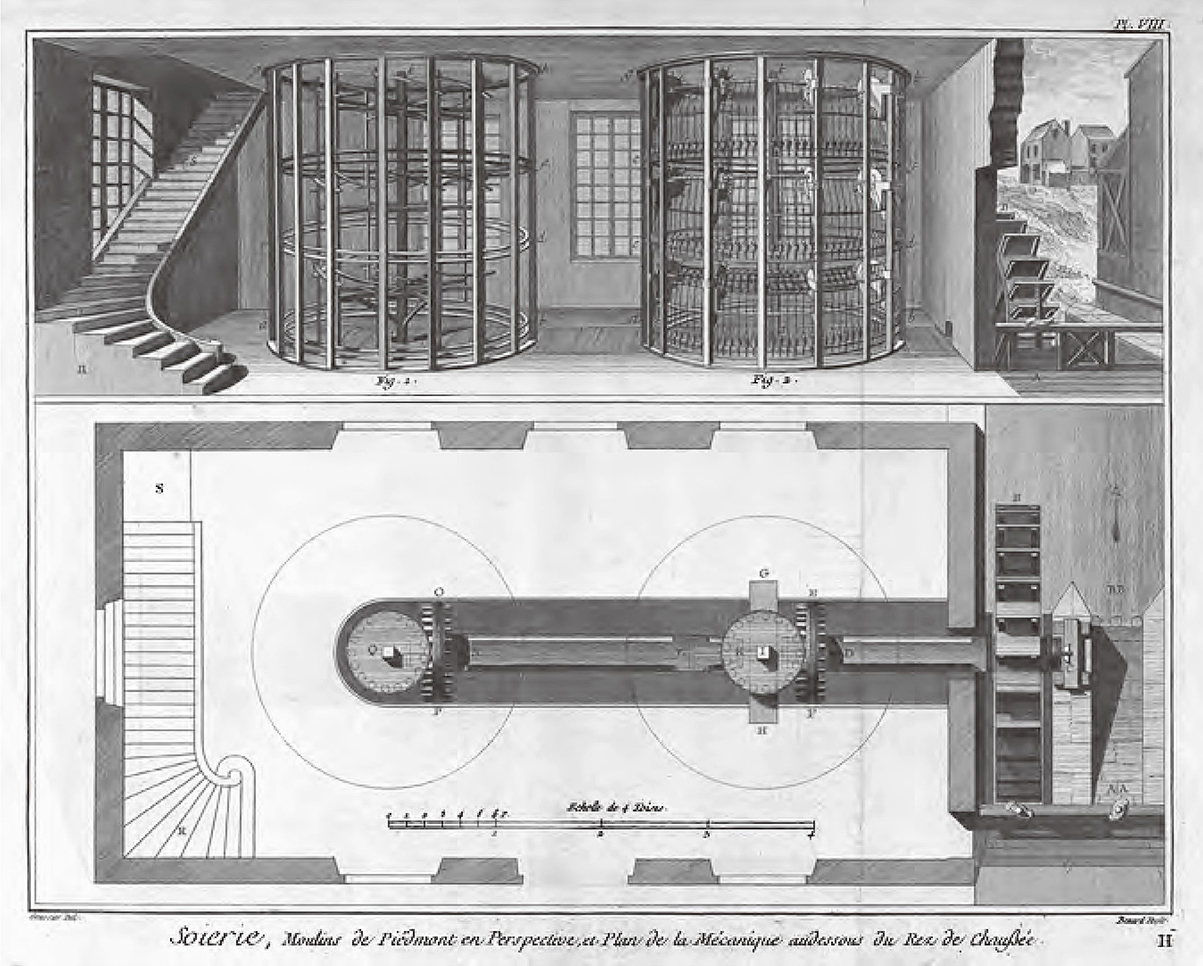
The Piedmont silk twisting machine depicted in the 18th century encyclopedia (Wellcome Collection)
The first machine twisted together silk threads that were almost invisible to the naked eye in a clockwise direction and wound them up on a slightly recessed horizontal spool. The second machine joins the two threads into one and then twists the threads together in a counterclockwise direction to make them stronger and more shiny. Its inner ring is not a bobbin, but an X-shaped winding machine with a side length of 2 feet, which can wind silk into a tow. The final product is "silk", which is "organzino" in Italian and "organzine" in French and English. The doubling step is important because the warp threads must be very tough; the warp threads are often drawn tight and the mechanical stress of the loom operation can easily break them. The thread that passes horizontally through the warp thread is called "weft thread", and its tenacity can be slightly lower. [To understand these two terms accurately, remember that the direction of the weft runs from left to right. The ancient saying "woof", although rarely used today, appears frequently in the literature and is synonymous with "weft".]
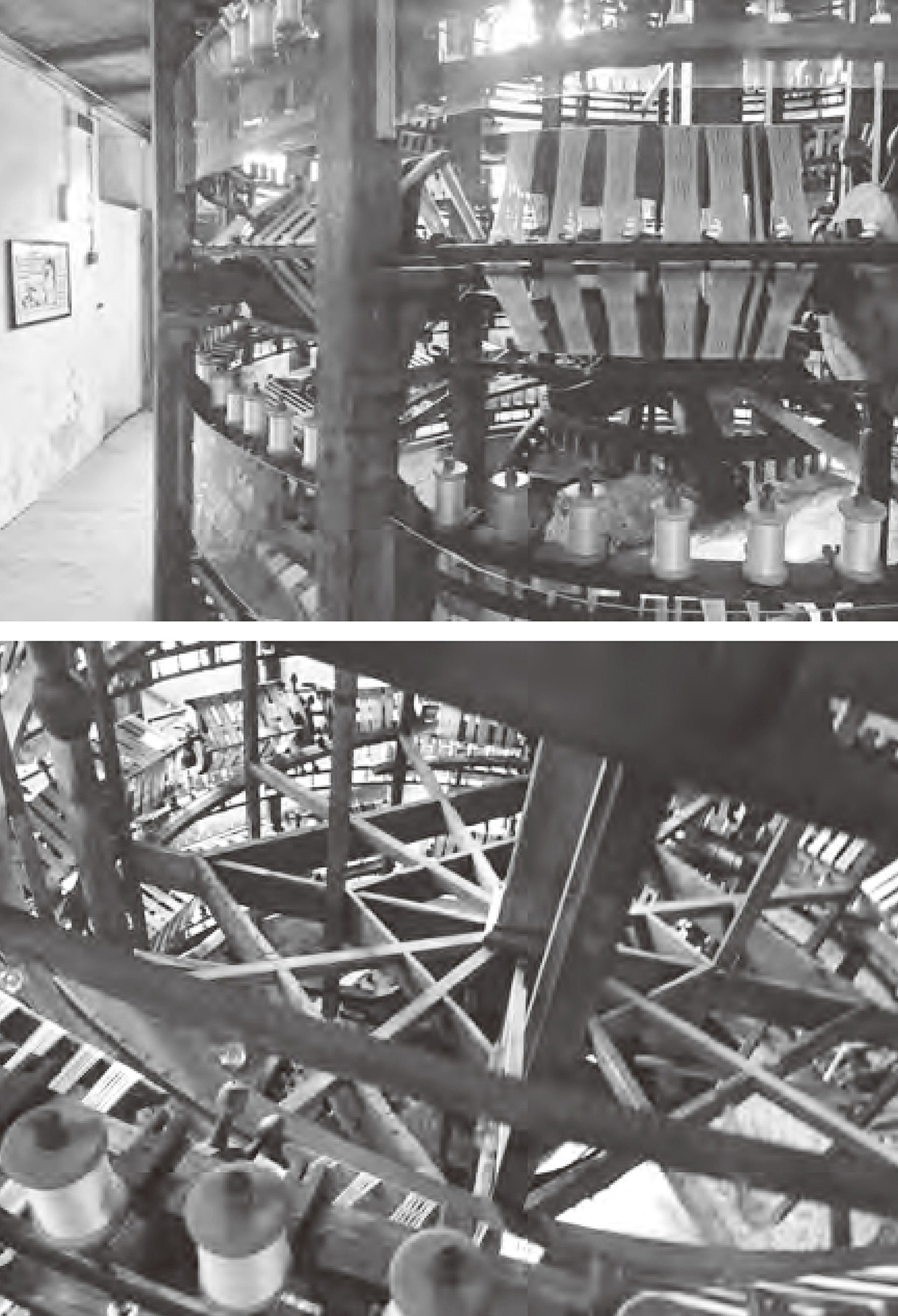
A close-up of the 1818 silk twisting machine, which is housed in the Civico Museo Seti cio Monti in Abbadia Lariana, Italy
This technology left a deep impression on people in the 21st century and was amazing at the time. The Bologna humanist Benedetto Morandi wrote in 1481 that he was proud of his city's industries and praised the operation of these twirling mills "without the help of humans, they only had to take care of the silk thread." A manual silk reeling worker working 12 hours a day can produce one spindle of thread. In contrast, a machine powered by water can produce 1000 spindles of wire, requiring only 2-3 machine caretakers to keep the base lubricated and repair broken wires. "It's a huge leap in productivity," said Flavio Crippa, who oversees the reconstruction of the Rosso silk twisting plant. He declared that the twister was "the godmother of a major structural change that largely went unnoticed."
Crippa is a physicist who has devoted his entire career to the modern silk industry, developing and applying for patents on advanced machinery. Over the past 20 years, he has invested a lot of effort in rediscovering and restoring lost technologies. His efforts have been witnessed by many museums across Italy, including the Rosso Silk Twisting Factory. Although the building was severely damaged during World War II, Crippa was still able to calculate the position and height of the machine by carefully observing the remaining traces."The biggest error is 2-3 centimeters," he said. He said with a smile that with the advantage of modern tools, it took two years to build the replicas-exactly like the original.
Although these hydraulic twirling plants originated in Bologna, they only really developed in northern Italy in Piedmont, Lombardy and the Venetian Republic, where there are abundant water and raw silk resources and insufficient supply of warp silk. At the end of the 17th century, wealthy Italian silk merchants and French silk manufacturers invested heavily in building about 125 factories at the foot of the Alps. These large factories supply large quantities of silk thread to the hungry looms of Lyon, Europe's silk capital.
In addition to using state-of-the-art machines, these Bologna factories also adopt a new organizational structure that allows all production stages-from harvesting cocoons to winding the silk thread into tows-to be completed in the same place. Crippa said: "This factory in Caragrio is the most fully functional silk thread factory ever built. People are accustomed to calling it Filatoio, but in fact it is a silk thread factory (Setificio) because its business is not limited to twisting silk threads. Its business covers the entire process of extracting silk thread from silkworm cocoons, twisting silk, and making thread." All factories in the region adopt this model.
A silk mill may employ hundreds of workers in one place: skilled silk reelers are called "maestre"(we are more familiar with the word "maestro","maestre" is its female plural) in recognition of their professional skills; children are responsible for winding raw silk onto bobbins; workers are responsible for operating machines; and carpenters and blacksmiths are responsible for repairing machines. There is even a convent at the Rosso Silk Mill, where nuns provide food and accommodation for female workers from distant areas.
Vertical integration has replaced the old family small industry. Silk reeling workers no longer work in independent workshops. Farmers will no longer take reeled raw silk home and wind it on bobbins. Only under strict supervision and standardization can the factory consistently produce silk threads tough enough to withstand the strict inspection of the hydraulic twist factory without breaking.
Piedmont's factory established a consistent size for the winding machine, installed a uniform metal bobbin, and calculated the optimal size and speed for the machine. They invented a mechanism called va e viene that distributes the thread evenly on the winding machine, thereby improving its quality. They began measuring the fineness of the thread by the weight of a standard length of thread (a concept still in use) and using machines that quickly measure test samples. One economic historian wrote that these twirling mills, with their technology, standardization and strictly supervised labor force, constituted "a factory system two centuries before the cotton mills of the British Industrial Revolution."
Piedmont's factory quickly established European standards for warp yarn, offered the highest prices, and expanded production to meet growing demand. The family that opened the Rosseau silk twisting factory made a lot of money selling silk threads, and King Savoy even made the patriarch of the family a hereditary count. As we stroll on the ground floor of the museum, Crippa points to underground excavations visible through the glass floor. They reveal how the operation of silk reeling increased from 10 stations in 1678 (each with a charcoal-fueled basin to maintain water temperatures) to 20 stations in 1720. There are two female workers working at each station (usually a mother and daughter), with the skilled female worker responsible for carefully extracting the fine filaments from the cocoons, while the less skilled worker responsible for winding the filaments onto a winding machine.
Compared with some nearby competitors, the three-story Rosso twist factory is not large. A year before it opened, French businessmen built a six-story factory in Racconigi, about an hour's drive to the northeast, employing 150 workers. Four years later, they built an 11-story factory with 300 workers. By 1708, the town of Rakniki had 19 silk thread factories employing 2375 workers.
However, management, measurement and machines are not the whole story. To the success of the factory, silk reeling experts are as critical as high-tech equipment. They can distinguish subtle differences in fiber size and match natural differences with filaments as closely as possible to keep the threads uniform and strong. Piedmont's silk reeling experts have also invented a unique technique that allows the filaments in two different basins to wrangle water to dry, making the filaments more elastic and rounded. Unlike their counterparts elsewhere, they only operate two filaments at a time to produce the finest silk thread on the market. Factories pay more attention to the quality of thread than the quantity. These silk reeling experts are paid daily rather than based on the number of thread they produce.
This is a highly demanding, highly skilled job that requires focus, experience and continuous improvement. Before graduating to become experts in silk reeling, these young female silk reeling women spent years observing the process and gaining tacit knowledge of how to handle fine filaments. "During the long period of low-paying apprenticeship, the rules, gesture patterns and all automatic hand movements that make up the art of silk reeling were gradually passed on from spinners to silk reeling workers," wrote one textile historian. This rare professional skill is difficult to replicate, making silk reeling experts sought-after employees, who earn higher wages than male workers.
In 1776, Spanish entrepreneurs established a silk thread factory in the town of Mercia. They hired a Piedmont silk reeling expert named Teresa Perona and offered a job to her husband, who was, in today's jargon, an "accompanying spouse." The factory demanded more of her job than her husband. She worked seven days a week while he only worked six. Her salary is 50% higher than his.
In a society where most people are still farmers, silk reeling experts are industrial aristocrats. In the mid-18th century, the Habsburg government funded a large complex of buildings in the town of Goriziano, near the border between what is now Italy and Slovenia. Like Rosso Silk Twisting Factory, it is also a largely self-sufficient park that includes residential areas and a small church. Rich wages and unprecedented "benefits" have attracted workers from all directions. The wages of skilled silk reeling experts are alarmingly high, so the locals are very angry. As a group of silk reeling masters wearing silk scarves wandered through the town, jealous residents threw stones at them, and the authorities had to intervene.
The economic historian Claudio Zanier believes that these hydraulic thread mills in northern Italy have cultivated "a very large female workforce fully capable of adapting to future industrial needs." He also discovered this in Japan's silk industry. In the 19th century, the area where silk twisting mills were concentrated became Italy's industrial hinterland-a status they still maintain today. Zane observed that "the products of these factories, in addition to a large number of professional craftsmen, also include a large and disciplined labor force who are accustomed to working in consecutive shifts seven days a week and are responsible for manufacturing high-quality products." "These are all necessary prerequisites for establishing an efficient modern factory system."
However, despite the great technological and organizational achievements of Italy's hydraulic thread mills, they are rarely mentioned in descriptions of how Western countries get rich. Historian John Styles said: "By 1750, there were approximately 400 hydropower plants in northern Italy south of the Alps. There are more hydropower plants than there were in Lancaster in 1800. So why didn't the Industrial Revolution happen here? Because silk is a luxury."
You wouldn't use silk sails to drive ships, you wouldn't pack goods in silk bags, you wouldn't use silk bandages to wrap wounds, you wouldn't decorate cottages with silk curtains, and you wouldn't let workers wear silk clothes. (Even in China, where military uniforms are made of silk, ordinary people wear clothes made of hemp fiber.) As long as mechanical innovations affect only a small group of elites, while they may enjoy prestige and generate profits, their economic significance is limited. Spinning staple fibers such as wool, linen and increasingly popular cotton into yarn remains a full-energy task. But with the mechanization of silk thread production, it has left cottages and entered factories, and these silk twisting factories heralded the coming of the Industrial Revolution.
three
In 1768, the British town of Warrington, in the middle of the River Mersey between Liverpool and Manchester, had largely recovered from the economic recession caused by the Seven Years 'War. Although demand for its canvas was not as strong as during the global conflict, it was enough to maintain the employment of 300 weavers. There are also 150 weavers weaving rough fabric for bagging.
However, these weavers only account for a small proportion of the total number of textile workers. Providing yarn to one weaver takes the work of 20 spinners-a workforce of 9000 people spread across rural Cheshire. Arthur Young, an agronomist and travel writer, wrote: "Spinning workers never stand still because they have no work; they can find work anytime they want; but weaving workers sometimes do nothing because of lack of yarn." He came to the town during a six-month trip through northern England.
Late in the trip, Young uncomfortably followed a "potholed" road before eventually reaching Manchester. There he saw a prosperous textile industry, producing products both for domestic consumption and for export to North America and the West Indies. There are many job opportunities. "Overall, there is a possibility that everyone will continue to have work to do," he wrote. He pointed out that in addition to the many workers who make small commodities such as textiles, hats and decorations, and strips of cloth,"the number of spinners employed in Manchester's urban and suburban areas is staggering." There are 30,000 spinners working in the urban area, and another 50,000 spinners working in the suburbs.
In Young's day, spinning was by far the largest industrial industry in the UK. One economic historian estimates that "adding wool, linen and hemp spinning together, the potential employment figure could be about 1.5 million married women by 1770," when the British working population was about 4 million (this calculation assumes that married women spun less than single women).
Spinning workers 'wages are moderate at best. Warrington's women and girls spin the linen fiber used to make canvas. If they work full-time, they can earn only 1 shillings a week, while a male weaver can earn 9 shillings a week and a female weaver can earn 5 shillings a week. In Manchester, adult cotton spinners earn 2-5 shillings a week, while girls earn only 1-1.5 shillings a week. In comparison, weavers earn between 3 and 10 shillings, depending on the type of fabric.
At first glance, it seems that the spinners are being treated unfairly. Historian Deborah Valenze wrote: "Although the spinning woman played a crucial role in England's economic destiny, her work paid meagre." She blamed low wages on gender discrimination. "Spinning has been stigmatized because it is associated with women's work, and spinners have never been paid wages commensurate with the demand for thread."
This simple moral story about oppressed female workers ignores mathematical problems that cannot be ignored in fabric production. Thread may be essential, but unless the final fabric is extremely expensive, the unit price per hour of spinning must be low. The wages of skilled silk reelers are high, higher than the wages of many men, because the fabric made from the silk thread they reel is expensive silk. Valenza reverses cause and effect. Spinning wages are low, not because women are working in spinning, but because it takes a long time to spin a large amount of useful yarn. An hour's labor is not worth that much money. Women take such low-paying jobs because they have fewer options than men. Oppression is not the wages paid to spinners, but the lack of other employment opportunities for women.
In fact, for those engaged in the fabric trade, the cost of spinning is not low-even if it is only paid a "meager wage." Its cost can easily exceed other steps in cloth production. In 1771, a parliamentary report recorded the cost of making a standard worsted cloth that sold for 35 shillings. The biggest expense was the raw wool itself, which cost 12 shillings; the spinners 'wages were closely followed: 11 shillings and 11.5p. Weaving costs half that-only 6 shillings. The manufacturer made a profit of 5 shillings and 5 pence.
This ratio is not abnormal either. For woolen suede, the cost of spinning is often twice that of weaving. In 1769, when the economy was so good that the cost of yarn to produce 25 yards of cloth was 17s. 11p, more than double the cost of weaving (8s. 9p). Five years later, when the price of fleece fell, the ratio was even more uneven: the spinners earned 15 shillings and 9p, while the weavers earned only 7 shillings.
Meager wages and high spinning costs reflect the basic economic conditions of pre-industrial fabric production. Cloth requires a lot of yarn and spinning requires a lot of time. It takes longer to spin fine, tight, and uniform threads. Providing looms with anything but the most luxurious materials is destined to come at a low price. Otherwise, no one can afford this fabric.
Spinning is the bottleneck in fabric production, and it is precisely the problem that needs to be solved urgently. Starting in the late 17th century, inventors began looking for ways to produce more yarn with less. Like cheap, clean energy today, spinning machines are clearly desirable. In 1760, the British Society for the Encouragement of Arts, Manufactures and Commerce awarded a prize for the creation of "a machine capable of spinning six threads of wool, linen, cotton or silk at the same time and requiring only one person to operate."
No one won the award, but a few years later James Hargreaves invented the Jenny spinning machine, a horizontal machine that promises to "simultaneously spin, stretch and twist 16 or more threads by turning (or moving) with one hand and pulling with the other hand." This is what the economic historian Beverly Lemire called "the first powerful machine capable of continuously producing multiple spindles of thread through the work of a single spinning woman." The Jenny spinning machine is ideal for home production and can be operated by even children. It speeds up spinning, improves thread uniformity, and increases the supply of yarn. More yarn, in turn, produces more woven fabrics and knitted stockings.
But quantity is not the only problem facing British textile manufacturers. Cotton is a short fiber and is difficult to spin into thread. Whether using a Jenny spinning machine or an old-fashioned spinning wheel, British spinners were unable to make cotton yarn tight enough to make warp yarns that could withstand constant tension without breaking. Spinning this short fiber into thread with a hand spindle takes a long time and the cost is prohibitively high. Therefore, British "cotton cloth" is actually a relatively rough cloth called "fustian". The weft yarn of this cloth is loose cotton thread and the warp yarn is linen.
What customers really want is fashionable cotton calico from India, where spinners are among the best in the world. However, at the behest of Britain's powerful wool industry, Parliament banned the import of cotton calico from India, and in 1774 even prohibited British manufacturers from selling their own calico. The British East India Company sold increasing amounts of Indian cotton cloth to the North American colonies, where Indian cotton cloth was more popular than British cotton and linen blended coarse cloth. British textile manufacturers want a piece of the American market. To achieve this, they need not only more cotton yarn, but also better quality cotton yarn. Stiles believes that spinning is "not only a bottleneck in textile production, but also a necessary condition for determining quality."
The British got the solution in a roundabout way from Italy's twirling factory. The story begins with industrial espionage that is common in the history of textiles. In the early 18th century, an English factory owner named Thomas Lombe sent his mechanically gifted brother John to Italy, hoping that he would master the secrets of Piedmont's silk reeling technology. John helped him by bribing a priest and found a job as a mechanic in a silk thread factory in Livorno. During the day, he memorized all these machines in his mind; at night, he drew the mechanical plan on paper, hid it in bundles of raw silk, and secretly transported it home. In 1716, he returned to England with several Italians and their professional skills. Using stolen mechanical plans, the brothers built a five-story silk twisting factory in Derby. It officially opened in 1722. That same year, John died of a long illness, said to have been caused by poison from an Italian assassin.
The British government was happy to reward a British national who introduced the most advanced technology (although Thomas obtained it through improper means) by granting him a patent for mechanical design. In 1732, when the patent expired, he requested an extension. Instead, Parliament gave him a staggering bonus of £ 14000-at the time, a family with an annual income of £ 100, which meant it belonged to the middle class; an annual income of £ 500, which meant it belonged to the rich class-on the condition that he would publish the mechanical plan and provide a "perfect model" of the twister so that others could copy it.
Soon after, an inventor named Lewis Paul, who was well-connected and whose father was a French refugee doctor, began applying the principles of the machine to cotton yarn production. His machine is equipped with a series of rolls, each spinning faster than the previous one, stretching and twisting combed fiber into threads, replacing manual skills with mechanical power. "This is a round machine with a central drive shaft and is strikingly similar in design to Lom's Italian silk twisting machine," Stiles wrote. Paul licensed the technology to investors he met through his friend, famous author Samuel Johnson.

Spinning on an Indian spinning wheel, circa 1860, painted by Kehar Singh
Paul's machines were used in factories in northern England, including a factory in Northampton that installed five machines with 50 spindles on each machine, but the machines had technical problems and were not particularly successful. (The factories also encountered management problems.) But roll spinning inspired other craftsmen. "Several gentlemen were almost bankrupt by this incident," admitted one of the diehards. His name is Richard Arkwright, a barber, wigmaker and pub owner in Lancashire. Despite his incredible background, Arkwright was a genius adept at improving others 'inventions and managed to find solutions to problems. Instead of using a circular body, he lined up pairs of rolls and weighted the top roll to replace the spinner's fingers to keep the fiber tight so that no twist occurred during drafting. As a result, the spun yarn is uniform and tight enough to be used as warp yarn.
In 1768, Arkwright moved to Nottingham's stocking knitting center, found several business partners, and applied for a patent for a machine that later became known as the "hydraulic spinning machine." His first spinning mill opened in 1772 and produced yarn used to make knitted stockings and chintz for sale to the American market. His business partner then successfully lobbied Parliament to repeal the ban on calico, allowing the fashionable fabric, now made from British yarn, to be sold legally across the country. Stiles writes that the water-spinning machine is the "ultimate macro invention"-a technology that can produce other technologies with implications far beyond a single function.
Within a few years, hydraulic spinning mills were all over northern England, producing large quantities of low-cost cotton yarn that had previously been unimaginable. Over time, Arkwright used hydraulic innovation to improve mechanical spinning, improve yarn quality, and integrate carding and woolen spinning (twisting fibers in preparation for spinning) into one process. He eventually added steam power to his spinning machine. Le Mire writes that the people operating the machines became "the first generation of industrial workers." Their incomes are high and the skills they use at work give them considerable prestige."
They are not the only winners, at least in the short term. In 1788, Samuel Crompton invented the "mule machine," called it because it combined Arkwright's design with the bobbin of Jenny's spinning machine. (A mule is a hybrid of a horse and a donkey.) For the first time, British manufacturers were able to produce yarn as fine, uniform and strong as Indian hand-spun cotton yarn. Yarn production has soared, and weavers have become a new bottleneck in fabric production.
"Those who worked in the hand-weaving industry experienced a golden period, did as much work as they wanted, and made high incomes," Le Mire wrote. The golden heyday will not last forever. The emergence of power looms at the turn of the century was followed by the famous Luddite movement, in which yesterday's winners became new economic losers. It is a historical irony that these hand weavers destroyed looms that threatened their work and became synonymous with resistance to new technologies, yet their livelihoods were threatened because of earlier and more devastating progress.
In fact, Arkwright's early "patent machine" also triggered strong resistance from anti-technology activists. Protesters smashed machines and demanded government relief. Before waiting for council action, the town of Wigan stopped the use of "all machines and engines used in combing, spinning and spinning cotton, whether they are powered by water or horses." A petition to Parliament explained: "The crux of the problem is the introduction of a variety of patented machines and engines that have replaced manual labor to such a deadly and horrific degree that... thousands of people... and their families are eager to find work."

19th century spinning cars
Parliament commissioned the drafting of a report but decided not to take action. The report concluded: "Due to the use of patented machines, a very important chintz manufacturing industry has been established in the above-mentioned areas." Despite the damage caused by new technology, it created new jobs and benefited the entire country.
There is a long but straightforward booklet titled "Thoughts on the Use of Machines in the Cotton Manufacture." Addressed to the Working People in That Manufacture and the Poor in General)。It details a case that also applies to streaming music, self-driving cars, drone delivery, and other industries where we fear robots are taking our jobs.
Those who are kicked out of old jobs find new jobs or learn new skills. Those whose labor remuneration is reduced will target more profitable businesses. Those who benefit greatly by taking the lead in exploiting new inventions will soon find that there are too many competitors and have to lower prices and reduce profits... In fact, cotton manufacturing is almost an emerging industry. The texture of the fabric, the quality of what we produce, has changed amazingly. How many new varieties of fabrics have we produced in large quantities? Without our machines, this would have been impossible to produce, at least not in large quantities, or sold so cheaply.
Although he may be overly optimistic about the individual's immediate destiny, the author of this pamphlet is right about the big picture. By making large quantities of yarn, these "patented machines" changed the world. From clothes to sails, from bed sheets and pillowcases to flour bags, the prices of daily necessities have suddenly become cheaper, with more varieties and easier to buy. Women are freed from spindles and spinning rods. This was the beginning of what the economic historian Deirdre McCloskey called the "Great Prosperity," a century-long economic boom that raised living standards across the world. Just as rope enabled early humans to conquer the world, abundant yarn had a ripple effect on every aspect of life.
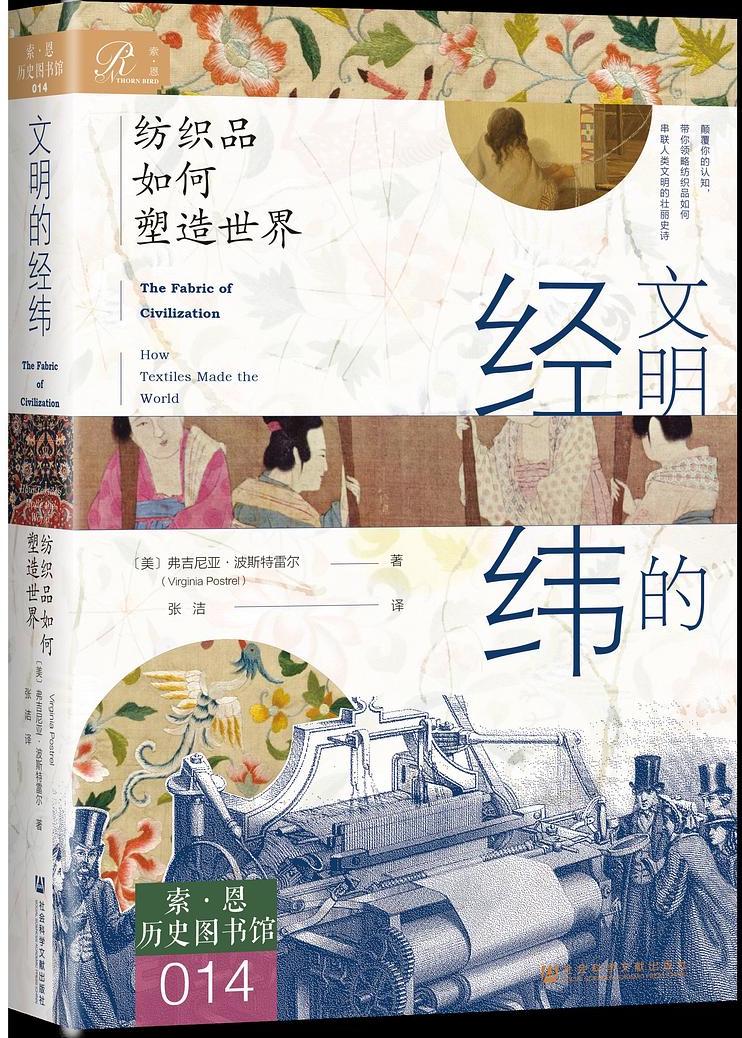
(This article is excerpted from Virginia Posttrell's "The Latitude and Length of Civilization: How Textiles Shape the World", translated by Zhang Jie, Social Science Literature Press, May 2024. The Paper News is authorized to be released, with the original annotations omitted, and the current title is prepared by the editor. Social Science Literature Press)



